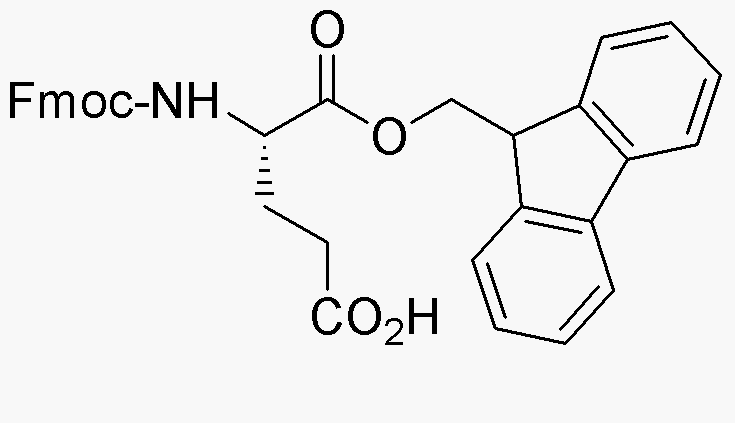Fmoc-L-glutamic acid a-9-fluorenylmethyl ester is widely utilized in research focused on:
- Peptide Synthesis: This compound serves as a key building block in solid-phase peptide synthesis, allowing researchers to create complex peptides efficiently. Its protective Fmoc group simplifies the deprotection process, enhancing yield and purity.
- Drug Development: In pharmaceutical research, it is used to develop peptide-based drugs. Its structure allows for modifications that can improve bioavailability and target specificity, making it valuable in medicinal chemistry.
- Bioconjugation: The compound is employed in bioconjugation techniques, where it can be linked to other biomolecules. This application is crucial in creating targeted therapies and diagnostic agents in the field of biotechnology.
- Protein Engineering: Researchers utilize it to modify proteins, enhancing their stability and functionality. This is particularly beneficial in developing enzymes with improved catalytic properties for industrial applications.
- Research in Neuroscience: Its derivatives are studied for their potential role in neurotransmitter modulation, contributing to advancements in understanding neurological disorders and developing therapeutic strategies.
General Information
Properties
Safety and Regulations
Applications
Fmoc-L-glutamic acid a-9-fluorenylmethyl ester is widely utilized in research focused on:
- Peptide Synthesis: This compound serves as a key building block in solid-phase peptide synthesis, allowing researchers to create complex peptides efficiently. Its protective Fmoc group simplifies the deprotection process, enhancing yield and purity.
- Drug Development: In pharmaceutical research, it is used to develop peptide-based drugs. Its structure allows for modifications that can improve bioavailability and target specificity, making it valuable in medicinal chemistry.
- Bioconjugation: The compound is employed in bioconjugation techniques, where it can be linked to other biomolecules. This application is crucial in creating targeted therapies and diagnostic agents in the field of biotechnology.
- Protein Engineering: Researchers utilize it to modify proteins, enhancing their stability and functionality. This is particularly beneficial in developing enzymes with improved catalytic properties for industrial applications.
- Research in Neuroscience: Its derivatives are studied for their potential role in neurotransmitter modulation, contributing to advancements in understanding neurological disorders and developing therapeutic strategies.
Documents
Safety Data Sheets (SDS)
The SDS provides comprehensive safety information on handling, storage, and disposal of the product.
Product Specification (PS)
The PS provides a comprehensive breakdown of the product’s properties, including chemical composition, physical state, purity, and storage requirements. It also details acceptable quality ranges and the product's intended applications.
Certificates of Analysis (COA)
Search for Certificates of Analysis (COA) by entering the products Lot Number. Lot and Batch Numbers can be found on a product’s label following the words ‘Lot’ or ‘Batch’.
Numéro de catalogue
Numéro de lot/série
Certificates Of Origin (COO)
This COO confirms the country where the product was manufactured, and also details the materials and components used in it and whether it is derived from natural, synthetic, or other specific sources. This certificate may be required for customs, trade, and regulatory compliance.
Numéro de catalogue
Numéro de lot/série
Safety Data Sheets (SDS)
The SDS provides comprehensive safety information on handling, storage, and disposal of the product.
DownloadProduct Specification (PS)
The PS provides a comprehensive breakdown of the product’s properties, including chemical composition, physical state, purity, and storage requirements. It also details acceptable quality ranges and the product's intended applications.
DownloadCertificates of Analysis (COA)
Search for Certificates of Analysis (COA) by entering the products Lot Number. Lot and Batch Numbers can be found on a product’s label following the words ‘Lot’ or ‘Batch’.
Numéro de catalogue
Numéro de lot/série
Certificates Of Origin (COO)
This COO confirms the country where the product was manufactured, and also details the materials and components used in it and whether it is derived from natural, synthetic, or other specific sources. This certificate may be required for customs, trade, and regulatory compliance.


